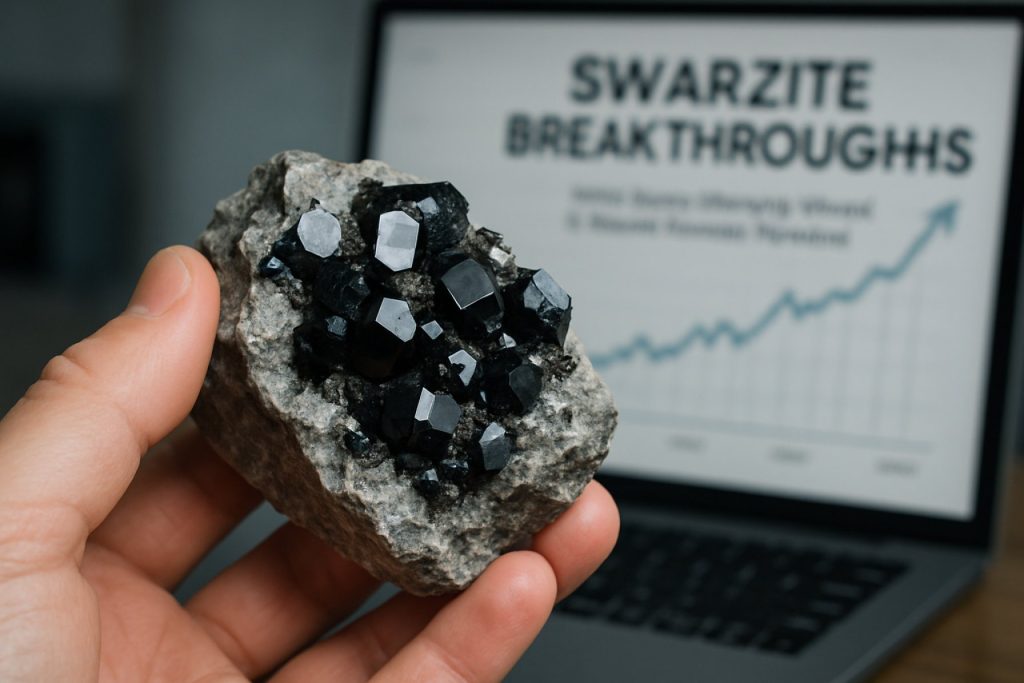
Unlocking the Future of Swarzite: 2025’s Definitive Mineralogical Analysis and What It Means for the Next Wave of Industry Innovation. Discover the Trends, Technologies, and Market Opportunities Set to Transform the Sector.
- Executive Summary: Swarzite’s 2025 Landscape
- Methodological Advances in Swarzite Mineralogical Analysis
- Current Market Size and Key Players (2025)
- Emerging Applications and Industrial Demand Drivers
- Technological Innovations Transforming Swarzite Analysis
- Global Supply Chain and Sourcing Trends
- Regulatory & Environmental Factors Impacting Swarzite
- Competitive Outlook: Manufacturer and Supplier Profiles
- Market Forecast: 2025–2030 Growth Projections
- Future Opportunities and Strategic Recommendations
- Sources & References
Executive Summary: Swarzite’s 2025 Landscape
Swarzite, a rare silicate mineral, has emerged as a focal point in advanced mineralogical analysis, driven by its unique crystal structure and potential applications in high-performance materials. As of 2025, the global landscape for swarzite analysis is shaped by increased demand for critical minerals, ongoing exploration initiatives, and advances in analytical instrumentation. Mineralogical studies are crucial for understanding swarzite’s geochemical behavior, purity, and potential industrial uses, particularly in the electronics and energy storage sectors.
Recent years have seen a surge in both academic and industrial research targeting the precise identification and characterization of swarzite. Major analytical laboratories and mining firms are employing state-of-the-art techniques such as X-ray diffraction (XRD), scanning electron microscopy (SEM), and electron probe microanalysis (EPMA) for in-depth compositional studies. This is exemplified by institutions like SGS, which provides mineralogical testing and advanced characterization services for rare minerals, supporting the global mining industry’s need for reliable data.
In 2025, robust demand from the electronics and specialty glass sectors is prompting mining companies to intensify exploration for swarzite-bearing deposits. Entities such as Rio Tinto and Anglo American, both renowned for their innovation in mineral extraction and processing, are collaborating with mineralogical laboratories to refine exploration models and improve resource estimation protocols. These companies have announced ongoing investments into analytical infrastructure, aiming to streamline the identification and beneficiation of swarzite and other rare silicates.
The outlook for 2025 and the ensuing years is shaped by several converging trends: the integration of automation and artificial intelligence into mineralogical workflows, increased scrutiny on traceability and sustainability, and evolving regulatory frameworks concerning critical mineral supply chains. Organizations such as the International Council on Mining and Metals (ICMM) advocate for best practices in mineral exploration and analysis, underscoring the importance of transparent reporting and environmental stewardship in swarzite projects.
Looking ahead, advances in analytical precision and data analytics are expected to further illuminate swarzite’s properties and expand its industrial potential. Strategic partnerships between analytical service providers, mining corporations, and technology developers are likely to accelerate the efficient discovery, extraction, and utilization of swarzite, positioning it as a material of interest in the next generation of technological applications.
Methodological Advances in Swarzite Mineralogical Analysis
The field of swarzite mineralogical analysis has experienced notable methodological advances over the past year, with further improvements anticipated through 2025 and beyond. Swarzite, a complex phosphate mineral primarily found in pegmatitic environments, presents analytical challenges due to its intricate crystal chemistry and frequent association with rare earth elements (REEs). Modern analytical techniques have increasingly focused on resolving these complexities and enabling more accurate mapping of the mineral’s structure and composition.
Electron microprobe analysis (EMPA) and scanning electron microscopy (SEM) coupled with energy-dispersive X-ray spectroscopy (EDS) have become standard in the precise elemental characterization of swarzite. These tools, supplied by industry leaders such as JEOL Ltd. and Thermo Fisher Scientific, are now equipped with advanced software for automated phase identification, allowing for rapid, reproducible results. In 2025, manufacturers have announced upgrades to detector sensitivity and data processing algorithms, which will further aid in distinguishing swarzite from closely related phosphate phases.
Another significant innovation is the integration of laser ablation inductively coupled plasma mass spectrometry (LA-ICP-MS) for in situ trace element analysis. This method, utilized in collaboration with instrumentation from Agilent Technologies and PerkinElmer Inc., has been essential in quantifying REE contents in swarzite, which is critical for both geological understanding and economic assessment of REE-bearing deposits. Recent developments focus on reducing detection limits and improving spatial resolution, enabling more detailed geochemical profiling of individual mineral grains.
X-ray diffraction (XRD) methods remain vital for crystallographic studies, with ongoing enhancements such as faster detectors and improved Rietveld refinement software. Bruker Corporation and Rigaku Corporation have both introduced next-generation diffractometers with automation features tailored for high-throughput mineralogical laboratories. These advances are expected to be widely adopted by academic and industrial labs by 2026, streamlining the analysis of swarzite’s complex crystal structure.
Looking forward, the outlook for swarzite mineralogical analysis is highly positive. The convergence of high-resolution imaging, sensitive trace element detection, and automated crystallography platforms promises a deeper understanding of swarzite genesis and paragenesis. Collaboration between academic researchers, mining companies, and instrument manufacturers is likely to drive further innovation, particularly as demand for REE-rich minerals intensifies. As methodologies continue to evolve, the precision and efficiency of swarzite analysis are set to improve, supporting both scientific discovery and resource development agendas.
Current Market Size and Key Players (2025)
As of 2025, the global market for swarzite mineralogical analysis remains niche but steadily expanding, driven by increased demand for rare earth elements and novel materials characterization in both academic and industrial sectors. Swarzite, a rare mineral within the phosphate group, is primarily sought after for its unique crystal chemistry and potential applications in advanced materials and geochemical research. The mineral’s occurrence is limited, with notable deposits identified in localities such as the Kola Peninsula (Russia) and select pegmatitic complexes worldwide.
The mineralogical analysis sector is characterized by a small number of highly specialized companies and research institutions. Key players in this field are largely concentrated in regions with established rare earth and specialty mineral industries. Leading laboratory service providers include SGS, a global leader in inspection, verification, testing, and certification, and Bureau Veritas, both of which offer advanced mineralogical and geochemical analysis services. These firms possess cutting-edge analytical capabilities such as X-ray diffraction (XRD), electron microprobe analysis, and laser ablation-inductively coupled plasma mass spectrometry (LA-ICP-MS), all pivotal for comprehensive swarzite characterization.
On the instrumentation side, major manufacturers such as Bruker and Thermo Fisher Scientific provide the analytical equipment crucial for swarzite studies. Bruker is recognized for its XRD and microanalysis platforms, while Thermo Fisher Scientific is a global supplier of electron microscopy and spectrometry solutions, both essential for detailed mineralogical investigations.
The current market size for swarzite-focused analysis remains modest—estimated in the low tens of millions USD on a global scale—reflecting the mineral’s rarity and the specialized nature of its study. However, there is a clear trend of growth, underpinned by increasing academic research output and the gradual integration of rare phosphate minerals into emerging high-technology sectors. Research institutes and universities with strong mineralogy and materials science programs, particularly in Europe and North America, represent significant demand centers.
Looking forward, the outlook for the swarzite mineralogical analysis market is positive. Demand is expected to increase incrementally over the next few years, supported by ongoing advancements in analytical technology and a growing appreciation for the role of rare minerals in next-generation materials development. Strategic collaborations between mining operators, analytical service companies, and academic institutions are likely to further bolster the sector’s growth and innovation trajectory.
Emerging Applications and Industrial Demand Drivers
Swarzite, a rare complex phosphate mineral, has drawn increasing attention within industrial and technological sectors due to its unique mineralogical properties and potential applications. As of 2025, research and pilot projects are intensifying, particularly in advanced materials science, energy storage, and environmental remediation. The mineral’s structure, typically containing rare earth elements (REEs) such as yttrium and cerium, positions it as a strategic material for several high-growth industries.
A key emerging application for Swarzite lies in the development of next-generation phosphors for LED lighting and display technologies. Its rare earth composition offers high quantum efficiency and thermal stability, making it a promising alternative to traditional phosphor sources. Companies specializing in advanced lighting materials, such as OSRAM and Philips, are expected to monitor developments closely, given their ongoing investment in rare-earth-based lighting technologies. However, direct commercial adoption awaits scalable extraction and purification methods for Swarzite’s complex matrix.
In the field of energy storage, Swarzite’s unique phosphate framework is being evaluated for use in novel battery chemistries and solid-state electrolyte formulations. Research consortia in collaboration with major battery manufacturers, including Panasonic and Samsung, are exploring rare-earth-doped phosphate materials for improved ionic conductivity and thermal resistance, critical for next-generation lithium-ion and sodium-ion batteries. The potential for Swarzite-derived materials to address supply chain vulnerabilities associated with conventional battery minerals is a compelling driver for continued investigation over the next few years.
Environmental remediation is another frontier where Swarzite’s sorptive and catalytic properties are being assessed. Its affinity for heavy metal ions and radionuclides suggests utility in water treatment and soil stabilization projects. Organizations such as Veolia, a global leader in environmental solutions, have expressed interest in mineral-based technologies for pollutant sequestration, aligning with broader trends toward sustainable remediation methods.
- Demand for Swarzite is expected to be shaped by advances in extraction technology, as its occurrence is typically associated with complex pegmatite ores requiring specialized processing.
- Industrial demand will also be influenced by regulatory policies favoring supply chain security for critical minerals, particularly those hosting rare earth elements.
- Strategic collaboration between mining operators, such as Lappland Goldminers, and end-users in the electronics and environmental sectors is likely to accelerate pilot-scale initiatives and commercialization pathways through 2028.
Overall, Swarzite’s mineralogical profile aligns well with the technological imperatives of the coming years, but its industrial impact will hinge on successful upscaling and integration into established and emerging value chains.
Technological Innovations Transforming Swarzite Analysis
The landscape of swarzite mineralogical analysis is undergoing a rapid transformation in 2025, propelled by the integration of advanced analytical technologies and digital solutions. The shift is primarily driven by the need for higher precision, faster throughput, and more environmentally sustainable practices in the mining and mineral processing industries. Swarzite, a complex rare earth mineral, poses analytical challenges due to its intricate composition and its occurrence alongside other rare earth elements.
One of the most significant technological innovations is the widespread adoption of automated scanning electron microscopy (SEM) systems equipped with energy-dispersive X-ray spectroscopy (EDS). These systems provide comprehensive mineralogical mapping, enabling analysts to distinguish swarzite from similar minerals with unprecedented accuracy. Leading instrument manufacturers such as Thermo Fisher Scientific and Olympus Corporation have introduced next-generation SEM platforms in 2024–2025, featuring enhanced resolution, automated mineral identification, and machine learning algorithms that reduce human error and accelerate data processing.
Another pivotal development is the increasing deployment of X-ray diffraction (XRD) and laser ablation inductively coupled plasma mass spectrometry (LA-ICP-MS) for swarzite analysis. Companies like Bruker and PerkinElmer have advanced their XRD and LA-ICP-MS product lines, focusing on improved detection limits and integrated software for real-time data visualization. These innovations allow for more detailed phase analysis and trace element quantification, which are critical in swarzite due to its economic importance in the rare earth supply chain.
Cloud-based data management platforms are also revolutionizing mineralogical workflows. Major mining and mineral processing groups are adopting digital solutions provided by firms such as Sandvik, enabling remote access, collaborative analysis, and integration with mine planning software. This digital transformation streamlines the swarzite analysis pipeline, allowing for faster decision-making and better resource allocation.
Looking ahead, the next few years are expected to bring further innovations, including the application of artificial intelligence for predictive mineralogy, portable analytical devices for field analysis, and expanded use of green chemistry protocols to minimize environmental impact. As demand for rare earth elements grows, particularly in the context of the global energy transition, technological advances in swarzite mineralogical analysis will play a crucial role in securing efficient and sustainable resource development.
Global Supply Chain and Sourcing Trends
The global supply chain for swarzite—a rare phosphate mineral increasingly recognized for its potential in advanced material applications—is evolving rapidly as its demand grows within sectors such as electronics and clean energy. As of 2025, the extraction and distribution of swarzite remain concentrated in select geographies, particularly in regions with established phosphate mining infrastructures. Notably, companies with diversified phosphate portfolios are investing in enhanced mineralogical analysis to optimize swarzite yield and purity, given its occurrence alongside other complex phosphates.
Leading phosphate producers, such as OCP Group (Morocco) and The Mosaic Company (USA), are leveraging advanced mineral characterization techniques to identify and selectively extract swarzite from broader phosphate ores. These multinationals are collaborating with equipment manufacturers to deploy real-time mineralogical analysis on-site, utilizing technologies like automated scanning electron microscopy (SEM) and X-ray diffraction (XRD) to ensure quality control and traceability within the supply chain.
In parallel, specialized mineral analysis service providers—often partnering with mining companies—are scaling up laboratory capacity and digital data integration. This is evident among firms supplying industrial analytical solutions, such as Thermo Fisher Scientific and Bruker Corporation. These players are at the forefront of supplying instrumentation and software platforms that enable precise swarzite phase identification, automated sample throughput, and the generation of actionable data for downstream supply chain decisions.
As sustainability and responsible sourcing gain prominence, swarzite supply chains are under increasing scrutiny from end-users and regulators. Industry associations such as the International Council on Mining and Metals (ICMM) are encouraging member companies to adopt traceability measures and to publish mineral provenance data. This is expected to lead to wider adoption of digital registry and blockchain technologies for swarzite and other critical minerals by 2026.
Looking forward, the outlook for swarzite mineralogical analysis will be shaped by ongoing investments in analytical infrastructure and digitalization across the supply chain. As new deposits are explored and existing operations are optimized, supply chain transparency and analytical rigor will be paramount for meeting the stringent requirements of high-tech markets. Key players are likely to form strategic alliances to secure access to advanced analytical tools and to ensure uninterrupted, high-purity swarzite sourcing over the next several years.
Regulatory & Environmental Factors Impacting Swarzite
Swarzite, a rare phosphate mineral, is increasingly drawing attention in the mineralogical and advanced materials sectors due to its unique properties and potential applications in energy storage and electronics. As the demand for specialty minerals intensifies, regulatory and environmental considerations surrounding swarzite are evolving rapidly, particularly in the context of 2025 and the years immediately ahead.
Regulatory frameworks for phosphate minerals, including swarzite, are shaped by both national mining authorities and international agreements aimed at responsible sourcing and environmental stewardship. In major mineral-producing jurisdictions, such as Australia and Canada, environmental impact assessments (EIAs) are prerequisites for exploration and extraction projects, ensuring that mining activities align with sustainability objectives and local community interests. Companies such as Rio Tinto and BHP, both with significant phosphate portfolios, adhere to rigorous environmental management plans that address waste handling, water use, and habitat restoration.
A key regulatory trend impacting swarzite is the tightening of restrictions on phosphate mining due to concerns about groundwater contamination and the release of hazardous byproducts. Regulatory bodies are increasingly mandating real-time monitoring of effluents and the adoption of advanced processing technologies that minimize environmental footprints. The International Council on Mining and Metals (ICMM) continues to update its sustainability protocols, which member companies are expected to implement by 2025. These protocols emphasize responsible tailings management, biodiversity protection, and community engagement, all of which have direct implications for swarzite exploration and production.
On the environmental front, the rare nature of swarzite means that even small-scale extraction can have outsized ecological impacts, particularly when deposits are located in sensitive or protected areas. This is spurring mining companies to invest in remote sensing and minimally invasive extraction techniques, as well as to pursue circular economy models that favor the recycling and re-use of phosphate-containing materials. The Mosaic Company, one of the world’s largest phosphate producers, is among those piloting new reclamation and land rehabilitation practices to mitigate long-term environmental effects.
Looking forward, regulatory scrutiny is expected to intensify as governments and industry bodies respond to global sustainability imperatives. The ongoing adoption of ESG (Environmental, Social, and Governance) criteria in the minerals sector will further drive transparency and accountability, influencing market access for swarzite and related phosphates. Innovations in mineralogical analysis, compliance tracking, and environmental monitoring will be crucial for maintaining social license and aligning with evolving regulations through 2025 and beyond.
Competitive Outlook: Manufacturer and Supplier Profiles
The competitive landscape for swarzite mineralogical analysis is characterized by a limited but growing cohort of specialized manufacturers and suppliers. As swarzite remains a relatively rare phosphate mineral, its analysis is predominantly undertaken within the broader context of rare earth and phosphate mineral studies, with involvement from key players in analytical instrumentation and mineral supply.
Prominent manufacturers of advanced analytical equipment—such as X-ray diffraction (XRD), scanning electron microscopy (SEM), and electron probe microanalysis (EPMA)—are crucial to swarzite analysis. Thermo Fisher Scientific Inc., a global leader in scientific instrumentation, provides high-precision analytical solutions widely adopted in mineralogical laboratories. Similarly, Bruker Corporation and Carl Zeiss AG offer advanced systems for microstructural and compositional analysis, supporting both academic research and industrial quality control.
Mineral supply chains for swarzite samples are maintained by niche geological material suppliers and mineral dealers. While swarzite is not a commercial ore mineral, its specimens are traded among collectors and used for reference in laboratories. Companies such as Minfind and Leben Minerals specialize in sourcing and distributing rare mineral specimens, including swarzite, to research institutions and private collectors worldwide.
In addition, mining and exploration companies with operations in phosphate-rich geological environments contribute to the supply of swarzite-bearing samples. While not the primary focus, these companies occasionally identify and document swarzite occurrences as part of broader mineral exploration programs. Notable industry bodies, such as the Institute of Materials, Minerals and Mining, play a supporting role by facilitating knowledge exchange and standards development in mineralogical analysis.
Looking ahead, the outlook for swarzite mineralogical analysis is poised for gradual expansion through advancements in analytical instrumentation and digitization of mineral databases. The integration of automated mineralogy platforms and artificial intelligence by leading manufacturers is expected to enhance the precision and throughput of swarzite analysis. Moreover, as global interest in rare earth and phosphate minerals intensifies, driven by strategic resource considerations, the demand for high-quality mineralogical analyses—including swarzite—will likely experience moderate growth through 2025 and beyond.
Market Forecast: 2025–2030 Growth Projections
The market outlook for swarzite mineralogical analysis between 2025 and 2030 is shaped by growing demand for rare earth element (REE) resources, advancements in analytical instrumentation, and the strategic importance of minerals characterization in global supply chains. Swarzite, a rare phosphate mineral containing both calcium and rare earth elements, is increasingly relevant in explorations targeting critical materials for high-tech and energy transition sectors.
Several factors are expected to drive the growth of swarzite mineralogical analysis services and technologies in the coming years. First, government initiatives in regions such as North America, Europe, and Australia are prioritizing the exploration and sustainable development of critical minerals, including those hosting REEs. This results in higher demand for precise mineralogical characterization to optimize resource extraction and processing strategies.
Leading mining and exploration firms, such as Rio Tinto, Glencore, and SRK Consulting, are expected to maintain and expand investments in advanced mineralogical laboratories and digital workflows. These companies often integrate automated mineralogy platforms—such as scanning electron microscopy (SEM) and X-ray diffraction (XRD)—to support both exploration and metallurgical optimization, which directly impacts the accuracy and efficiency of swarzite identification and quantification. For example, SRK Consulting is recognized for their global network of mineralogical laboratories, which are actively being upgraded to handle new analytical challenges posed by complex REE-bearing minerals like swarzite.
Instrumentation manufacturers such as Bruker and Thermo Fisher Scientific are also expected to launch next-generation analytical tools between 2025 and 2030, with improved automation, resolution, and data integration capabilities tailored to rare mineral analysis. The adoption of such technologies will likely reduce turnaround times and costs, making swarzite analysis more accessible to junior explorers and mid-tier mining companies.
Looking ahead, market projections for swarzite mineralogical analysis anticipate annual growth rates in the high single digits, supported by expanding exploration budgets, increased regulatory scrutiny, and the need for detailed mineralogical models in resource estimation. The sector is also expected to benefit from partnerships between analytical service providers and mining companies, facilitating innovation in both laboratory and on-site mineral analysis. As the global push for critical minerals intensifies, the strategic role of accurate swarzite characterization is set to increase, underpinning resource security and sustainable supply chains through 2030 and beyond.
Future Opportunities and Strategic Recommendations
The mineralogical analysis of swarzite—a rare phosphate mineral with potential applications in advanced materials and energy sectors—is poised to benefit from several emerging opportunities in 2025 and beyond. A key driver is the intensifying global demand for critical minerals essential to electronics, renewable energy, and high-performance materials, which is motivating both public and private stakeholders to re-examine underexplored mineral resources like swarzite.
In the current landscape, companies with expertise in mineral extraction and processing, such as Rio Tinto and Glencore, are strategically positioned to lead explorations into swarzite-bearing deposits, especially as they expand efforts to secure supplies of rare earth elements and specialty phosphates. Advanced mineralogical characterization, utilizing automated mineralogy platforms and hyperspectral imaging, is being adopted by leading laboratory technology providers like Thermo Fisher Scientific to improve the identification and beneficiation of rare minerals, including swarzite.
Strategically, the next few years will likely see increased collaboration between mining firms, research institutions, and technology developers to optimize extraction and processing methods. Investment in pilot-scale studies and demonstration projects—often in partnership with universities or national laboratories—will be crucial to establish economic feasibility and environmental best practices, particularly in regions with known swarzite mineralization.
- Resource Mapping and Exploration: Leveraging geospatial data and AI-driven mineral prediction models, companies can identify new swarzite occurrences, with Anglo American and BHP among the industry leaders developing digital exploration capabilities.
- Processing Innovation: The refinement of extraction techniques—such as selective leaching or ion-exchange processes—will be essential, and laboratory solution providers like Bruker are expected to advance analytical instrumentation supporting these efforts.
- Sustainability and Compliance: Focus on environmental impact reduction will encourage adoption of closed-loop water systems and low-energy beneficiation, aligning with evolving standards from international industry bodies like the International Council on Mining and Metals.
Looking forward, the swarzite sector’s growth will depend on the successful integration of advanced mineralogical analysis, sustainable extraction technologies, and cross-sector partnerships. Proactive regulatory engagement and transparent supply chain management will further enhance the strategic value of swarzite, positioning it as a potential contributor to the critical minerals economy of the late 2020s.
Sources & References
- SGS
- Anglo American
- International Council on Mining and Metals
- JEOL Ltd.
- Thermo Fisher Scientific
- PerkinElmer Inc.
- Bruker Corporation
- Rigaku Corporation
- OSRAM
- Philips
- Veolia
- Olympus Corporation
- Sandvik
- The Mosaic Company
- Thermo Fisher Scientific
- Bruker Corporation
- International Council on Mining and Metals
- Rio Tinto
- The Mosaic Company
- Carl Zeiss AG
- Minfind
- Institute of Materials, Minerals and Mining
- Rio Tinto



